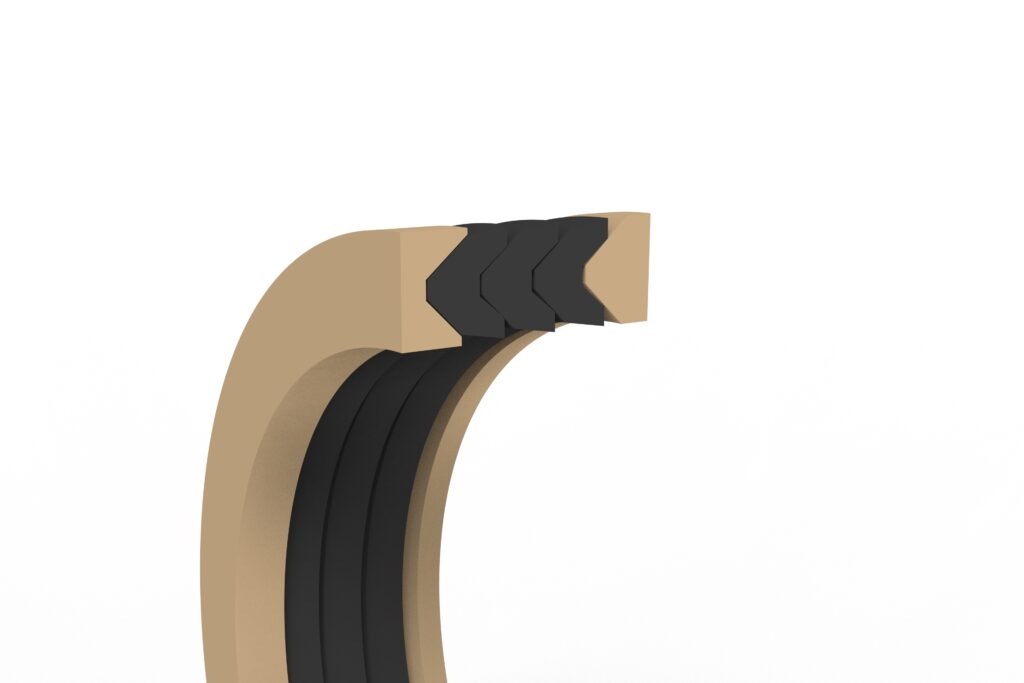
Chevron packing, also known as V-Seals or Vee packing, is a versatile sealing solution widely used in hydraulic systems and other industrial applications. These seals are designed with multiple lip configurations that provide excellent sealing capabilities in both static and dynamic applications. Chevron packing is typically composed of a combination of a male adapter, a female adapter, and several intermediate V-rings.
Design and Functionality: Chevron packing sets are designed to handle high-pressure environments and compensate for wear and misalignment. The V-shaped rings in the packing set act as individual seals, which are energized by the system pressure. This unique design allows each ring to react independently to pressure changes, providing a reliable seal even under varying conditions. The male and female adapters help to compress the V-rings and maintain the seal integrity.
Materials: Chevron packing can be manufactured from a variety of materials to suit different operational environments. Common materials include fabric-reinforced nitrile, PTFE, HNBR, EPDM, FKM, and PEEK. This diversity in materials allows Chevron packing to be used in applications with extreme temperatures, aggressive chemicals, and high mechanical stresses.
Applications: Chevron packing is used across various industries due to its adaptability and robust performance. Typical applications include:
Advantages:
Overall, Chevron packing (V-Seals) is an essential component for ensuring reliable and efficient sealing in high-demand industrial applications. Its design flexibility and material options make it a preferred choice for engineers looking to optimize the performance and longevity of their equipment.
| Specification | Details |
| Pressure Capacity | Maximum of 10,000 psi (70 MPa) |
| Operational Speed | Varies depending on materials |
| Temperature Range | -200°C to +260°C | -328°F to 500°F |
| Material | Description | Temperature Range |
| HNBR | HNBR (Hydrogenated Nitrile Butadiene Rubber) stands out as a premium sealing material, offering enhanced resistance to chemicals, oils, and temperatures, making it particularly suitable for harsh environmental conditions encountered in the oil and gas industry. Notably, HNBR showcases superior strength and retention of properties after long-term exposure to heat, oil, and chemicals, surpassing the performance of standard NBR. | -30°C to 150°C -22°F to 302°F |
| FKM | FKM (Fluoroelastomer) is highly regarded in the sealing industry for its exceptional resistance to high temperatures, chemicals, and aging, making it indispensable in aerospace, automotive, and chemical processing sectors. This material thrives across a wide temperature range, enabling its use in extreme conditions where other materials would fail. FKM’s remarkable compatibility with a wide variety of chemicals, including oil, fuel, and solvents, along with its ability to withstand harsh environmental factors, ensures its preference for high-performance seals, O-rings, and gaskets. Its robustness and longevity under aggressive conditions underscore FKM’s value as a premier choice for demanding sealing applications. | -20°C to 200°C -4°F to 392°F |
| TFE/P | Aflas, a fluoroelastomer developed by AGC Chemicals, is renowned for its outstanding performance in extreme environments, making it indispensable in various industries such as oil and gas, automotive, chemical processing, and food and pharmaceuticals. Composed of tetrafluoroethylene and propylene (TFE/P), Aflas excels with its exceptional heat resistance, tolerating continuous service temperatures up to 232°C (450°F), and demonstrates remarkable chemical resistance to strong acids, bases, oils, amines, and steam. Its durability is further enhanced by its resistance to oxidative and thermal degradation, ensuring longevity and reliability in aggressive conditions. Additionally, Aflas offers excellent electrical insulation properties, making it suitable for applications requiring high electrical resistivity. | -25°C to 232°C (-13°F to 450°F) |
| Molybdenum Disulfide (MoS2) PTFE | Improves wear resistance, reduces friction, temperature tolerance up to 260°C (500°F), used in difficult lubrication applications. | -200°C to 260°C (-328°F to 500°F) |
| Carbon PTFE | Improved compressive strength and reduced creep, better thermal conductivity and wear resistance, higher friction coefficient, temperature up to 260°C (500°F). | -200°C to 260°C (-328°F to 500°F) |
| Material | Description | Temperature Range |
|---|---|---|
| Unfilled PEEK | Unfilled PEEK provides exceptional mechanical and chemical resistance properties at high temperatures. It is used in demanding applications such as bushings, bearings, wear pads, and seals. It has excellent abrasion resistance and maintains its properties over a wide temperature range. Common applications include aerospace, automotive, and chemical processing industries. | -70°C to 260°C (-94°F to 500°F) |
| Glass Filled PEEK | Glass Filled PEEK offers enhanced mechanical and thermal properties, making it suitable for applications requiring higher tensile and shear strength. It is commonly used in structural components, automotive, and aerospace applications due to its excellent resistance to harsh chemical environments. | -70°C to 260°C (-94°F to 500°F) |
| Glass Filled PTFE | Teflon (PTFE) is renowned for its outstanding chemical resistance, low friction, and high-temperature stability. It is widely used in applications like gaskets, seals, and bearings in the chemical processing, automotive, and aerospace industries. PTFE’s ability to maintain its properties at very low and very high temperatures makes it a versatile material for various industrial applications. Glass Filled PTFE offers improved compressive strength, reduces creep, and enhances wear resistance. | -200°C to 260°C (-328°F to 500°F) |
For comprehensive support on housing details or to explore potential solutions tailored to your application, we invite you to book a meeting with us
